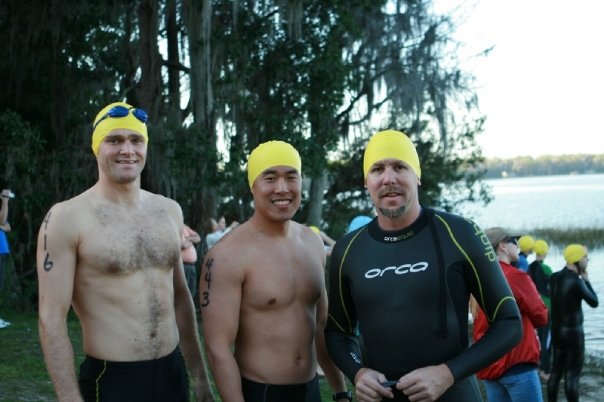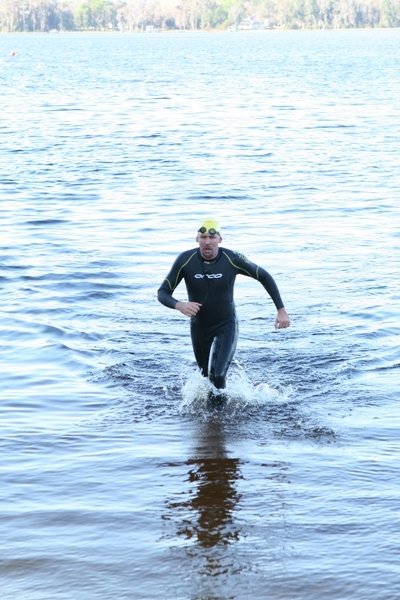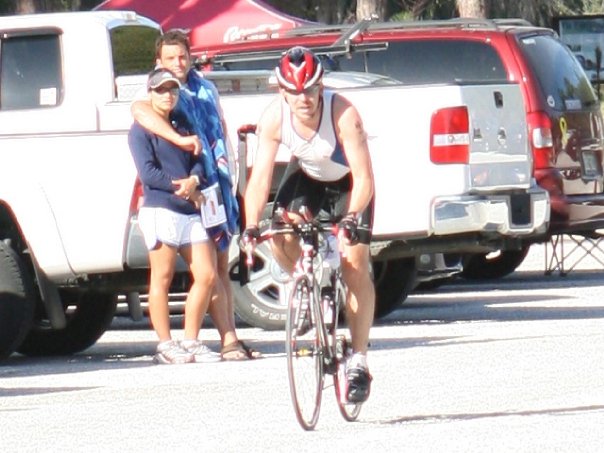The third and final stop of the Waldo Triathlon series was March 8 at 9:30AM. This was intended to be my second triathlon, having done the sprint distance in the second stop and now the Olympic (also called international or intermediate) distance for the third stop.
Since I was forced to drop from the second stop last month, this will actually be my first time putting all three sports together into one triathlon event.
Pre-race
We left Jacksonville at 6:00AM to head down to Waldo, which is just north east of Gainesville. Packet pick-up started at 7:00 and it didn’t really seem to make sense to stand around for two and a half hours, so we aimed for arrival at 7:30 or shortly thereafter.
Packet pick-up (if you didn’t attend the previous afternoon) is on-site near the transition area. The race staff were unable to locate my packet, so they created a couple of makeshift numbers (one for bike, one bib) for me and off I went.
I got a good spot in the transition area (always prefer to be on the last rack off the aisle in the closest row to the bike exit) and set up my gear. I checked the air in my tires and was finished by about 8:15 or so. Since the race didn’t start until 9:00, this gave me some time to stand around and relax with my wife and our friend, Tiffany, before donning my wetsuit and heading to the start area.

Swim
The swim start for the third stop is a wave start whereas the first two stops use a mass start. There are a couple of reasons they the race director does this. First, being the later event (the first two stops are in January and February), the last stop draws a larger field of athletes. Second, they offer a long course in this stop as opposed to just the sprint and Olympic distance courses in the first two stops. Add to the fact that they run a duathlon and a triathlon event for each distance in this series and they have six races going on at one time. Obviously, that’s a lot of moving pieces.
The sprint distance starts in the first wave and then a few minutes later, the Olympic and long distance event start. The start is a wade start, meaning you wade into the water and everyone takes off from essentially a standing position in the water.
The swim went a little better than I had expected. I should preface this by saying that swim is my weakest sport and also the one that I’m having the most challenge focusing on during training. It was obvious in the second stop that the swim is where I need to focus most on my training. In that event, I swam the 750m in about 17:30, so I expected that the 1,500m swim in this event would take me around 36:00. I ended up finishing in about 28:23, however. Most of the swim was still in the backstroke with almost all of the remaining swim in the breaststroke. Very little was in the freestyle, which ultimately is my goal.
I realized while swimming in this event that my problem with the swim portion is that my endurance is not sufficient to space out my breathing enough to synchronize it with my swim strokes. As a result, swimming in the backstroke allows me to breath at the rate I need without screwing up my stroke. I’m beginning to come to terms with the fact that this may simply be the product of having smoked for so many years and that it may be a very long road to recovering from it.
Coming out of the swim, I was near the back of pack, as opposed to being in the middle during the second stop. I will touch more on this later in my performance analysis, but the two events had a very different field of athletes. This stop had a couple of very competitive college teams (Virginia Tech and Auburn) that made up a large portion of the field. This is very obvious when looking at the average swim times, bike speeds and transition times.
Transition went well, especially since I didn’t have trouble getting my wetsuit off. Being able to feel what your fingers are doing really makes a difference in completing this task. I spent about three minutes in transition and headed out with my bike for the cycle portion.

Bike
I don’t think I realized at the start of the bike portion how much the swim had taken out of me. In comparison with my speed on the bike last time, I was more than two and a half miles per hour slower. There was a little bit of a wind this time, but I don’t know that it was enough to make too much of a difference. I was riding the triathlon bike this time, and while I don’t know that it makes me much faster, it certainly shouldn’t make me any slower, and I was certainly averaging a lower speed that most of my training rides on this bike have been lately.

The bike course is fairly flat and is a 6.2-mile out-and-back course. For the Olympic distance, athletes complete two loops of it. I was starting to get tired by the return of the second loop and could feel the slight changes in elevation, even though they were very small.
I think my turns and corners were good, as was my turnaround at the end points. It was easy for me to get back up to speed after each of these.
I had stored a FiberOne bar on my bike prior to the race in case I felt like I needed something to eat. During the first leg of the course, I decided that I should eat something, even if I didn’t feel all that hungry. Whether this was a mistake or not, I don’t know, but a FiberOne bar was probably not the best choice. Looking back at it, I don’t think it really added much value.
Transition again went very well and I was able to change shoes, swap my helmet for a visor and take off pretty quickly, spending about a minute in transition. I ate a gel as I came out and started pulling off my cycling gloves, planning to just store them in the back pocket of my jersey.
My goal on the bike was 18 mph for a time of 1:20 but I came in around 1:23 because I only averaged 17.83 mph. I’m not disappointed with my ride, so much as confused why I didn’t perform better. Again, I think it was just from being tired from the swim.
Run
There’s no other way to describe the run portion of this race — I bonked only a mile or so into it. I don’t know if my problem was the FiberOne bar, or dehydration, or if I was just plain tired. Something was definitely off and I suspect that the combination of swim and bike had taken their toll.
I alternated running and walking through the 6.2-mile course. It was humiliating and discouraging, but there wasn’t really anything I could do about it. I averaged an embarrasing pace of 11:36 per mile.
My goal for this race was 3:11:05 and my overall time ended up being 3:08:52. While I’m happy with the overall time, I missed some of the specific goals within that time, such as the bike speed and run pace. I exceeded my goals on the swim time as well as times in both T1 and T2.
Post-race Analysis
As I mentioned earlier, the field of athletes in this event was significantly different from the first and second stops in this series. For example, a large portion of the Olympic distance event was comprised of college athletes who are part of the Virginia Tech or Auburn triathlon teams.
I projected a longer period of time to complete the swim than what I actually needed, based on my performance during the swim portion of the February event. In that event, I out-swam 45% of my fellow athletes in the sprint distance. For that matter, my Olympic distance time in the March event would have beat 60% of the athletes in February. However, with the college teams added to the mix, the average swim time for the sprint dropped from 17:45 to 12:35. My time from February would have only beat about 33% of the athletes in the March event. Similarly, more than 85% of the athletes against whom I swam in the Olympic distance this past weekend had faster times than mine.
In reviewing the bike speeds, I was much slower in the March event than I have been during training lately. I suspect that this has to do with underestimating the toll that the swim would take on me, and will demand some changes to the way in which I train for Gulf Coast Triathlon in May.
In February, I averaged 20.65 mph on the bike, in comparison with only 17.83 mph in March. As would be expected due to the different field of athletes, the average speed on the sprint distance changed from 16.36 to 17.94 mph, whereas the Olympic distance saw a change from 18.88 to 19.83 mph. My average speed in February was the fastest of the athletes in the sprint, and faster than 85% of those in the Olympic distance. In March, I was faster than only 47.83% and 23.88% of
the athletes in the sprint and Olympic distance events respectively.
Even the average transition times saw a similar reduction, with T1 dropping from almost four minutes to just over two minutes. There was a much smaller change in T2 times as it changed from 1:30 to about 1:20.
In retrospect, I believe that what happened is that I used more energy on the swim than I expected, which was primarily the result of insufficient training in my weakest sport. In turn, this caused me to ride much slower on the bike and as I tried to control this by pushing harder. Despite the increased force, I was unable to sustain my normaml speed, which likely also caused me to run out of energy when I transitioned into the run. There are also some lessons to be learned about nutrition and hydration here, though again, these are lessons with which I should already be familiar.
Although my time was with the acceptable range for my goals, there were several failures in different parts of my performance that could have (and undoubtedly should have) been avoided. Regardless, the end result is still an acceptable time for an Olympic distance and my first triathlon.
→ See also: 2009 Waldo Triathlon – Stop 2


